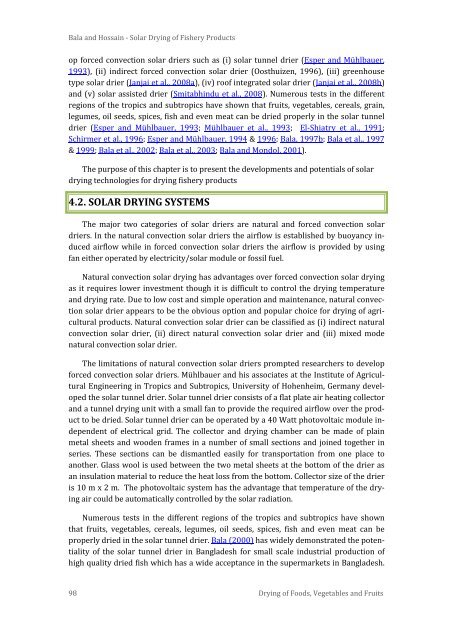Solar Drying: Fundamentals,Applications and Innovations - National ...
Solar Drying: Fundamentals,Applications and Innovations - National ...
Solar Drying: Fundamentals,Applications and Innovations - National ...
You also want an ePaper? Increase the reach of your titles
YUMPU automatically turns print PDFs into web optimized ePapers that Google loves.
Bala <strong>and</strong> Hossain - <strong>Solar</strong> <strong>Drying</strong> of Fishery Products<br />
op forced convection solar driers such as (i) solar tunnel drier (Esper <strong>and</strong> Mühlbauer,<br />
1993), (ii) indirect forced convection solar drier (Oosthuizen, 1996), (iii) greenhouse<br />
type solar drier (Janjai et al., 2008a), (iv) roof integrated solar drier (Janjai et al., 2008b)<br />
<strong>and</strong> (v) solar assisted drier (Smitabhindu et al., 2008). Numerous tests in the different<br />
regions of the tropics <strong>and</strong> subtropics have shown that fruits, vegetables, cereals, grain,<br />
legumes, oil seeds, spices, fish <strong>and</strong> even meat can be dried properly in the solar tunnel<br />
drier (Esper <strong>and</strong> Mühlbauer, 1993; Mühlbauer et al., 1993; El-Shiatry et al., 1991;<br />
Schirmer et al., 1996; Esper <strong>and</strong> Mühlbauer, 1994 & 1996; Bala, 1997b; Bala et al., 1997<br />
& 1999; Bala et al., 2002; Bala et al., 2003; Bala <strong>and</strong> Mondol, 2001).<br />
The purpose of this chapter is to present the developments <strong>and</strong> potentials of solar<br />
drying technologies for drying fishery products<br />
4.2. SOLAR DRYING SYSTEMS<br />
The major two categories of solar driers are natural <strong>and</strong> forced convection solar<br />
driers. In the natural convection solar driers the airflow is established by buoyancy induced<br />
airflow while in forced convection solar driers the airflow is provided by using<br />
fan either operated by electricity/solar module or fossil fuel.<br />
Natural convection solar drying has advantages over forced convection solar drying<br />
as it requires lower investment though it is difficult to control the drying temperature<br />
<strong>and</strong> drying rate. Due to low cost <strong>and</strong> simple operation <strong>and</strong> maintenance, natural convection<br />
solar drier appears to be the obvious option <strong>and</strong> popular choice for drying of agricultural<br />
products. Natural convection solar drier can be classified as (i) indirect natural<br />
convection solar drier, (ii) direct natural convection solar drier <strong>and</strong> (iii) mixed mode<br />
natural convection solar drier.<br />
The limitations of natural convection solar driers prompted researchers to develop<br />
forced convection solar driers. Mühlbauer <strong>and</strong> his associates at the Institute of Agricultural<br />
Engineering in Tropics <strong>and</strong> Subtropics, University of Hohenheim, Germany developed<br />
the solar tunnel drier. <strong>Solar</strong> tunnel drier consists of a flat plate air heating collector<br />
<strong>and</strong> a tunnel drying unit with a small fan to provide the required airflow over the product<br />
to be dried. <strong>Solar</strong> tunnel drier can be operated by a 40 Watt photovoltaic module independent<br />
of electrical grid. The collector <strong>and</strong> drying chamber can be made of plain<br />
metal sheets <strong>and</strong> wooden frames in a number of small sections <strong>and</strong> joined together in<br />
series. These sections can be dismantled easily for transportation from one place to<br />
another. Glass wool is used between the two metal sheets at the bottom of the drier as<br />
an insulation material to reduce the heat loss from the bottom. Collector size of the drier<br />
is 10 m x 2 m. The photovoltaic system has the advantage that temperature of the drying<br />
air could be automatically controlled by the solar radiation.<br />
Numerous tests in the different regions of the tropics <strong>and</strong> subtropics have shown<br />
that fruits, vegetables, cereals, legumes, oil seeds, spices, fish <strong>and</strong> even meat can be<br />
properly dried in the solar tunnel drier. Bala (2000) has widely demonstrated the potentiality<br />
of the solar tunnel drier in Bangladesh for small scale industrial production of<br />
high quality dried fish which has a wide acceptance in the supermarkets in Bangladesh.<br />
98 <strong>Drying</strong> of Foods, Vegetables <strong>and</strong> Fruits

















